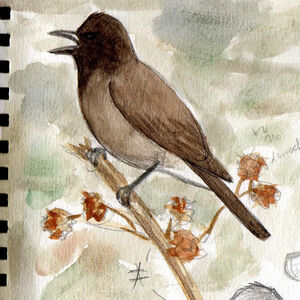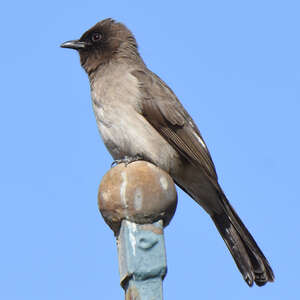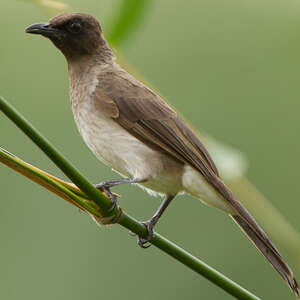Common Bulbul
Pycnonotus barbatus - Bulbul des jardins
Identification
The Common Bulbul is a bird smaller than the Blackbird and especially slimmer. It also has a large tail, but the overall appearance is different.
The plumage is plain, without any striking characteristic and there is no sexual dimorphism. The female is only slightly smaller.
Upper parts are medium-brown with hints of fawn. The head is hooded in dark brown, the face becoming almost black and includes an eye, also black. The beak is black, strong and slightly curved in appearance. Remiges and rectrices are a darker brown, appearing blackish in low light. The tail exceeds the short wings greatly. Robust black legs.
Lower parts are whitish to beige-brown depending on illumination, sometimes with a chestnut-brown plastron on the chest, with the rear sides marked in russet-brown. The undertail covert are almost white and constitutes the lightest part of the body.
The silhouette in flight and the flight itself are quite characteristic: long tail, short rounded wings, yet flight is fast and direct with emphasis beating, very different to a large thrush. And in the tree-filled habitat, there are no other species to confuse it with, except a few other bulbuls on the margins of its range (see further). Furthermore it is very vocal, which facilitates detection.
There are five Pycnonotus barbatus subspecies which differ slightly in plumage details, but are geographically separated.
It is close to other species with which it was still recently confused, P. somaliensis, dodsoni, tricolor and xanthopygos, with the last three obviously distinguished by the field of yellow undertail coverts.
Subspecific information 10 subspecies
- Pycnonotus barbatus barbatus (Morocco to Tunisia)
- Pycnonotus barbatus inornatus (s Mauritania and Senegal to w Chad and n Cameroon)
- Pycnonotus barbatus gabonensis (c Nigeria and c Cameroon to Gabon and s Congo)
- Pycnonotus barbatus arsinoe (e Chad, n and c Sudan and e Egypt)
- Pycnonotus barbatus schoanus (se Sudan, w, c and e Ethiopia, Eritrea)
- Pycnonotus barbatus dodsoni ()
- Pycnonotus barbatus somaliensis ()
- Pycnonotus barbatus spurius ()
- Pycnonotus barbatus layardi ()
- Pycnonotus barbatus tricolor ()
Foreign names
- Bulbul des jardins,
- Bulbul naranjero,
- tuta-do-norte,
- Graubülbül,
- barna bülbül,
- Grauwe Buulbuul,
- Bulbul golanera,
- trädgårdsbulbyl,
- Hagebylbyl,
- bylbyl bradatý,
- bulbul zahradní,
- Berber-bulbul,
- kyläbulbuli,
- bulbul de ventre blanc,
- Garðaglymur,
- bilbil ogrodowy,
- dārzu bulbulis,
- bulbul,
- Бородатый настоящий бюльбюль,
- アフリカヒヨドリ,
- 黑眼鹎,
- trädgårdsbulbyl,
- 羽鬚鵯,
Voice song and call
The song of the Common Bulbul is a short (about 2 seconds) and loud musical phrase made up of 8-10 fluid and slightly rolled notes, all pleasant to the ear. It is very often dominant over other songs and creates a special background atmosphere in the places it inhabits, often in humanized surroundings (parks and gardens, even in cities). And since the species is usually large and gregarious, its presence cannot be ignored, especially since it is often common and gregarious.
The cries, quite varied, are composed of repeated notes, sharp and piercing tsit, tsit, tsit and worried tsep, tsep, tsep with variations on this pattern depending on the bird's mood. Interactions are accompanied by rapid sequences of sound notes.
Habitat
This species is related to different types of woody plants, whether they are shrubs, bushes or trees, and since it is mainly frugivorous, it is very related to woody plants with fleshy fruits.
Behaviour character trait
Common Bulbuls live in territorial pairs, or in family groups after reproduction. They are usually very vocal and are often the first birds to sing in the morning, but are not shy with their voices throughout the day either. Singers will not hesitate to perch prominently. They share trees with other frugivores and are not shy around humans, taking advantage of the extra food they provide.
Flight
Dietfeeding habits
The Common Bulbul is an opportunistic feeder, consuming both small invertebrates (insects) and vertebrates (small lizards) as well as items of plant origin such as fruits, seeds, buds and fleshy flowers, but its diet is still predominantly frugivorous.
For example, a study in NE Africa gave 72% of fruits, 14% of flowers and 14% of insects. It can also scavenge foods of anthropogenic origin in urban parks, wild bird feeding stations, picnic areas, chicken coops, etc. It mainly explores woody plants to feed, but it can also be seen looking for food on the ground. The most consumed fruits are drupes with more than half of the total. The Common Bulbul is attracted to black-colored fruits, which represent a third of the total.The Common Bulbul is an active disperser of the seeds of the plants from which it consumes the fruits.
Reproduction nesting
The Common Bulbul is monogamous, and its partners are reputed to be loyal. Prior to reproduction, the two companions strengthen their marital bond through appropriate behaviours, mutual preening, duets,.
The Common Bulbul builds its nest, more or less well hidden in a tree fork, at a height ranging from 1 to a few metres from the ground. It is a small structure, for the bird's size. The female lays 2 to 5 eggs in it, the incubation of which lasts about 14 days. She usually incubates alone. The young are born naked and are fed and raised by both parents. The fledging takes place between 10 and 17 days after the hatching.Geographic range
The nominate subspecies occurs in the Maghreb. The other subspecies are distributed in a sub-Saharan belt extending from Mauritania and Senegal to the west, to Eritrea and Ethiopia to the east, passing through Nigeria, Chad and Sudan. The range extends south into Central Africa where it reaches Gabon and southern Congo. This Common Bulbul is resident in its range.
Threats - protection
Sources of information
- IOC World Bird List (v15.1), Gill, F and D Donsker (Eds). 2025-12-07.
Other sources of interest
 Specification sheet created on
27/07/2023 by Jean François
Specification sheet created on
27/07/2023 by Jean FrançoisTranslation by AI Oiseaux.net
© 1996-2025 Oiseaux.net
- Accipitriformes
- Aegotheliformes
- Anseriformes
- Apodiformes
- Apterygiformes
- Bucerotiformes
- Caprimulgiformes
- Cariamiformes
- Casuariiformes
- Charadriiformes
- Ciconiiformes
- Coliiformes
- Columbiformes
- Coraciiformes
- Cuculiformes
- Eurypygiformes
- Falconiformes
- Galliformes
- Gaviiformes
- Gruiformes
- Leptosomiformes
- Mesitornithiformes
- Musophagiformes
- Nyctibiiformes
- Opisthocomiformes
- Otidiformes
- Passeriformes
- Pelecaniformes
- Phaethontiformes
- Phoenicopteriformes
- Piciformes
- Podargiformes
- Podicipediformes
- Procellariiformes
- Psittaciformes
- Pterocliformes
- Rheiformes
- Sphenisciformes
- Steatornithiformes
- Strigiformes
- Struthioniformes
- Suliformes
- Tinamiformes
- Trogoniformes

































